Meal prep at London Zoo
A VERY PRECIOUS BIRD

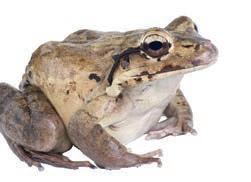
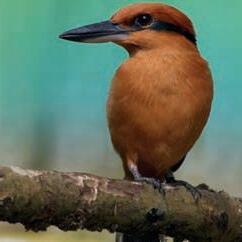

A day in the life of our brown bears
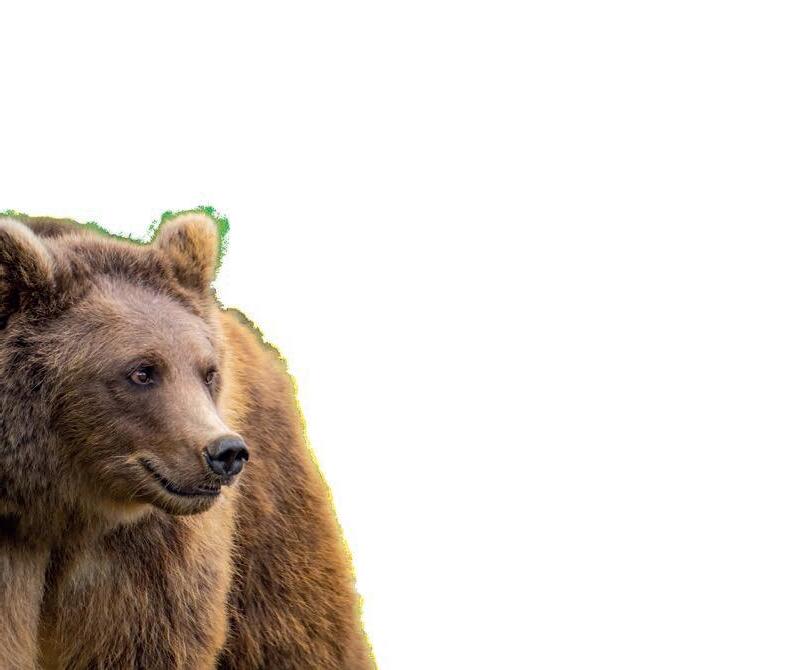
Enter The BEAR
NECESSITIES
I TAKE
CAN
YOUR ORDER?
A VERY PRECIOUS BIRD
This year, Claire McSweeney from Whipsnade’s bird team journeyed to Sedgewick County Zoo in Wichita, Kansas to support the breeding of extinct-in-the-wild sihek.
“Caring for the rare chicks is a round-the-clock job, involving feeding, monitoring and weighing them to make sure they’re in the best of health,” explains Claire. “With only 137 of these birds in the entire world, the four fluffy brown chicks we raised from eggs felt incredibly precious.
“Sihek weigh as little as five grams when they hatch, and they’ll grow 10 times that until they’re ready to fly. By hand-rearing chicks, we can ensure a lot more chicks reach it to adulthood than they would otherwise.”

Sihek, or Guam kingfishers as they’re also known, disappeared from Guam in the 1980s. We’re working with partners on Guam and in the United States to breed enough sihek so that releases back into the wild can begin.
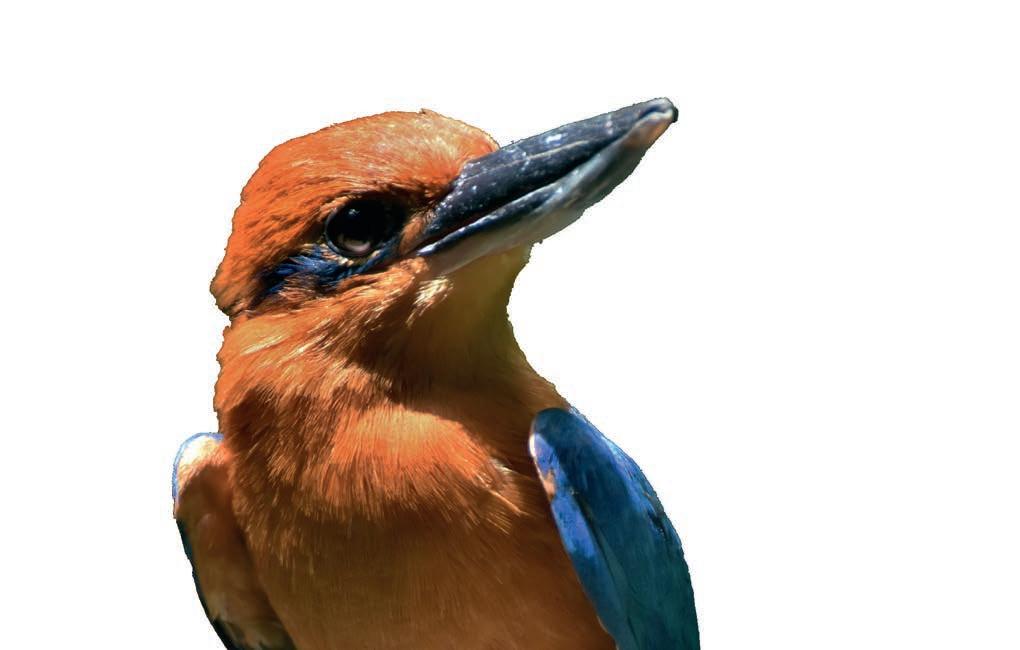

WILD ABOUT / AUTUMN 2023 2
Wild About is the magazine for Gold Members, Fellows and Patrons of ZSL London and Whipsnade Zoos
ZSL London Zoo, Regent’s Park, London NW1 4RY
Tel: 020 7722 3333 zsl.org
Registered Charity No. 208728

For more information about Membership, please contact our supporter contact team on 0344 225 1826.
Editor: Jonathan Kemeys

Design: Suzie Black/Alliance Creative wildabout@zsl.org
With thanks this issue to: Will Amlot, Holly Bestley, Laura Birch, Tina Campanella, Stephanie Deas, Gemma Dipple, Emma Edwards, John Ewan, Sam Facey, Hannah Fisk, Georgie Gerard, Matthew Gould, Charlotte Gurden, Joy Hadfield, Veronica Heldt, Catherine Howes, Laura Laird, Bethan Laughlin, Claire McSweeney, Gemma Metcalf, Angela Robinson, Gonçalo M Rosa, Vicki Sage, Yasmin Sajjad, Ben Tapley, Gillian Therese and family, Craig Walker, Alastair Wilkinson, Elizabeth Witcombe.
Wild About is printed on paper certified by the Forest Stewardship Council (FSC) and contains elemental chlorine free (ECF) fibre, which comes from wellmanaged forests. Your copy of the magazine is sent to you in a recyclable envelope. Wild About is published three times a year and distributed to ZSL Gold Members and supporters. No part of Wild About may be reproduced or used in any form or by any means, either wholly or in part, without prior written permission from ZSL. ZSL cannot guarantee the return of unsolicited articles, photographs, etc. ZSL reserves the right to refuse an advertisement without explanation. ZSL does not necessarily endorse any of the products or services advertised. When you have finished with this issue please recycle it or share it!
OUR DUTY TO WILDLIFE
Irecently found myself wading through a muddy River Roding, under an overpass, on the outskirts of East London. I was on the hunt for critically endangered European eels. As cars rumbled over the bridge above us, two conservationists and I examined an eel trap. ZSL has eel traps at several locations in London, monitoring the arrival of young eels to our rivers. Every day between April and September the traps are checked, the eels weighed and then released.
Sadly, there were no eels on the day I visited. Though, perhaps this shouldn’t be a surprise – eel sightings at tributaries across Greater London have dropped by around 90% in the last 25 years. This is partly down to man-made obstacles, like dams, and the high levels of pollution.
On page 14, you’ll read about how eels arrive in UK rivers at around two years old, having already completed a 6,500km journey across the Atlantic to get there. We have a duty of care to ensure these brave creatures encounter healthy and navigable rivers when they arrive, and we’re already working with the likes of Thames Water and the Environment Agency to make that happen.
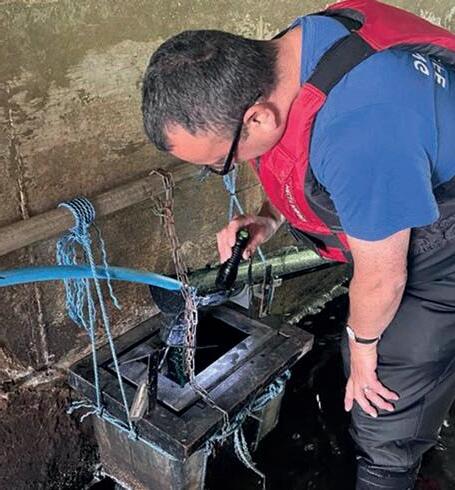
On page 2, to the left, you’ll see a Guam kingfisher. The smaller photo was taken in Wichita, Kansas, where one of our zookeepers has been helping to breed the birds for a reintroduction programme. Guam kingfishers went extinct because of the accidental introduction of nonnative tree snakes to the island. I’m delighted that we’re part of a project working to right that wrong.
Closer to home, our zookeepers, horticulturalists and countless others are working hard to get The Secret Life of Reptiles and Amphibians ready for visitors. Conservation is at the heart of the new centre; almost all of the species you’ll see are threatened with extinction, and the technology we’ve
built into each of the exhibits will help us to learn more about our animals. Several of the species we care for are so rare that little is known about them, so finding out the mechanisms that underpin their breeding, or how they might deal with climate change, is vital to their long-term conservation.
I’m really grateful to be leading an organisation that puts the protection of wildlife and nature at the heart of all it does, and achieves so much around the world for so many species. And I’m grateful to you, our members, for helping us make it happen.
ON THE HUNT FOR EELS IN THE RIVER RODING
NEWS FROM THE ZOOS AND BEYOND OPERATION PANGOLIN
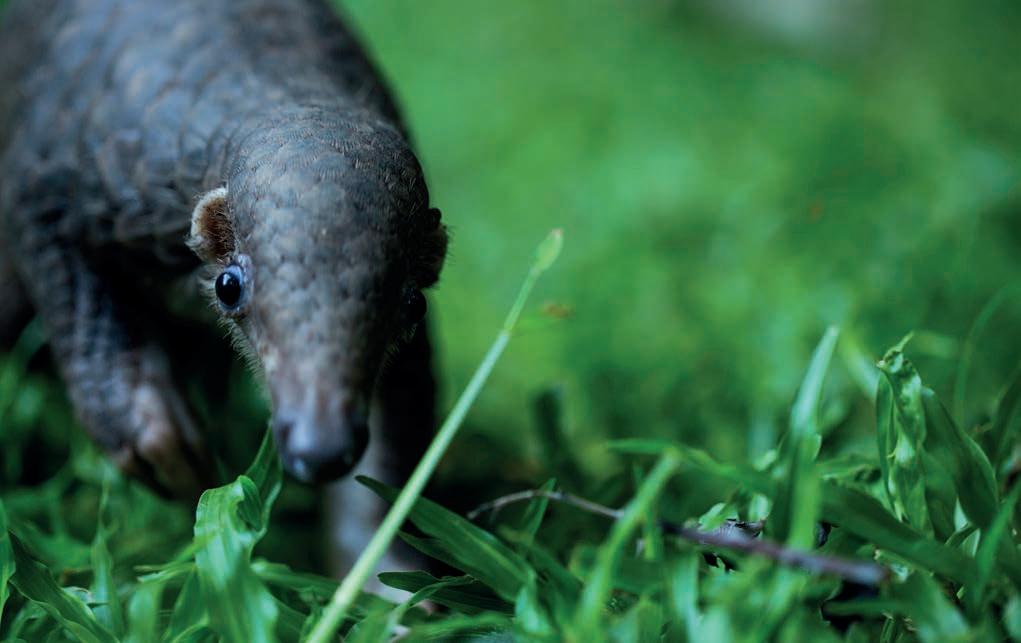
Pangolins, also known as scaly anteaters, are famously dubbed the ‘world’s most trafficked mammal’. Their use in traditional medicine and as a delicacy in Asia has made them extremely valuable for poachers, which has led to all eight species of pangolin now being threatened with extinction. It is thought that, in Africa alone, 8.5 million pangolins were removed from the wild and smuggled illegally between 2014 – 2021.
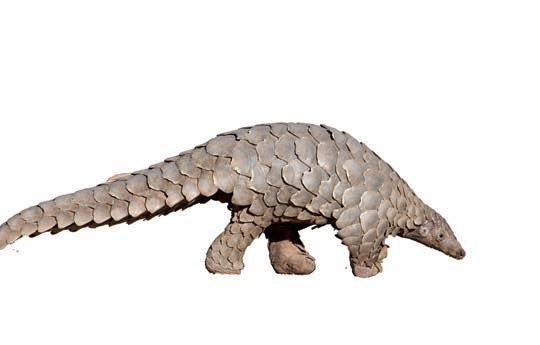
That’s why, this year, we have joined forces with Florida International University and other partners, with funding from the Paul G. Allen Family Foundation, to form Operation Pangolin. Our team will lead the project in Cameroon,
ALL ABUZZ IN TINY GIANTS

On your next visit to London Zoo’s Tiny Giants, look out for our new beehive. “The bees are a type of Italian honeybee, with a gentle temperament and a low honey yield,” says Craig Walker, Team Leader of Invertebrates. “We won’t be having fresh honey on our toast in the zookeeper kitchen just yet – we’ll let the bees keep the honey they make this year. They’ll eat it through winter, and it gives the young colony the best chance to survive the cold months.” Bees pollinate our plants and crops (like the one used to make your cereal) but they’re struggling because of lack of habitat and the use of pesticides. You can help by planting wildlife-friendly flowers in your garden, or building a bug hotel for bees to hibernate in.
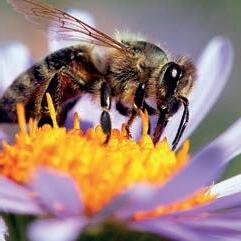
COMING TOGETHER FOR CLIMATE CHANGE
This December, the annual meeting of the United Nations Framework Convention on Climate Change (UNFCCC) will take place in Dubai. The heatwaves and extreme weather events we have experienced this year are more proof that climate change is an issue we must face together. At the coming conference, a team from ZSL will be championing the role nature can play in combatting climate change, as well as the threat climate change poses to biodiversity worldwide. We’ll be highlighting our work to restore mangroves in the Philippines and Mozambique, or seagrass meadows and native oyster beds around the UK, and the role they play in biodiversity restoration and carbon storage. We’re also going to be partnering with Royal Botanical Gardens at Kew, and the Natural History Museum, to highlight the role we can play in the protection of the planet.
PEEK-A-BOO AT WHIPSNADE ZOO
Meet Yentu, the newest addition to our François’ langur family. Yentu was born a bright, tangerine orange, like all babies of his species. It’s an evolutionary technique that helps parents keep an eye on their young and encourages the whole troop to look after them. Over the coming months Yentu’s fur will turn black like his mum and dad, Lee Lee and Wang, and he’ll grow the incredible white sideburns they are known for. There are only around 2,000 François’ langurs left in China and Vietnam, where they come from, so Citrus isn’t just a pretty face either – he’s a valuable addition to the breeding programme!
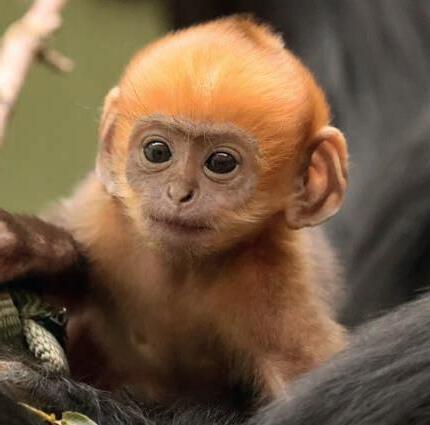
MOST
WANTED:

THE WATER VOLE
HAVE
YOU SEEN THIS RODENT? WE NEED YOUR HELP!
From the River Crane to the River Lea, we’re looking for volunteers and animal spotters to take part in a city-wide survey of the Thames and its tributaries. Water voles are about the size of a guinea pig and were once a common sight across the UK but have declined by over 90% in the last century. Their disappearance was driven largely by loss of habitat and the accidental introduction of American mink to our waterways. American mink were imported to the UK for their fur in the 1920s but escaped the fur farms and have since spread across the country. Mink are semiaquatic predators and their sleek bodies mean they can squeeze into water vole burrows and kill whole colonies living along a riverbank.
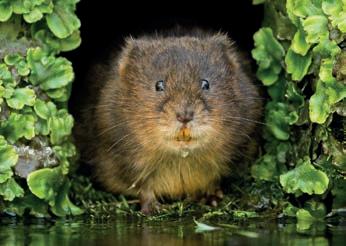
With mink now being controlled on many of the UK’s waterways, it’s hoped that water voles may be able to recover. However, little is known about how they’re doing – which is why we need eagle-eyed river users to let us know if they spot one (or their nemesis, the American mink). Water voles have fluffy, chestnut-brown faces that are much blunter than a rat (though they are similar in size) and their round ears are almost entirely hidden beneath their fur. You may also spot burrows in muddy riverbanks, or piles of nibbled grass and cigarshaped droppings by the riverbank.
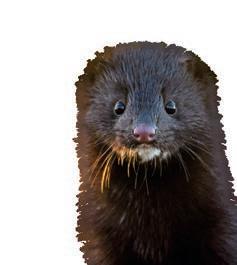
If you’re keen to get even more involved, we’re also looking for volunteers to help us set up survey sites across London.
To take part in the London Water Vole Recovery Programme, or to report your sightings, visit: zsl.org/water-vole
5 WILD ABOUT / AUTUMN 2023
THE SECRET LIFE OF REPTILES AND AMPHIBIANS
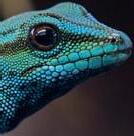

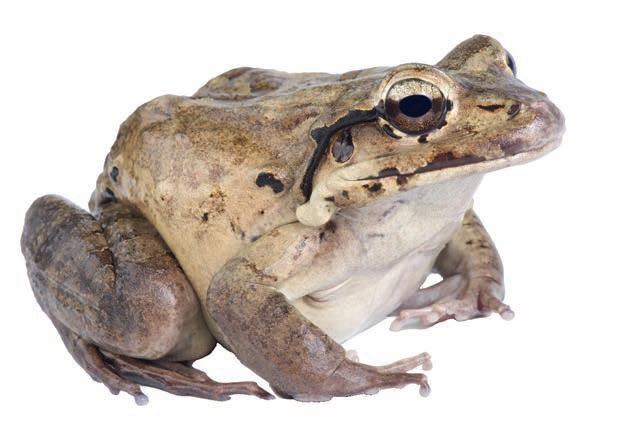
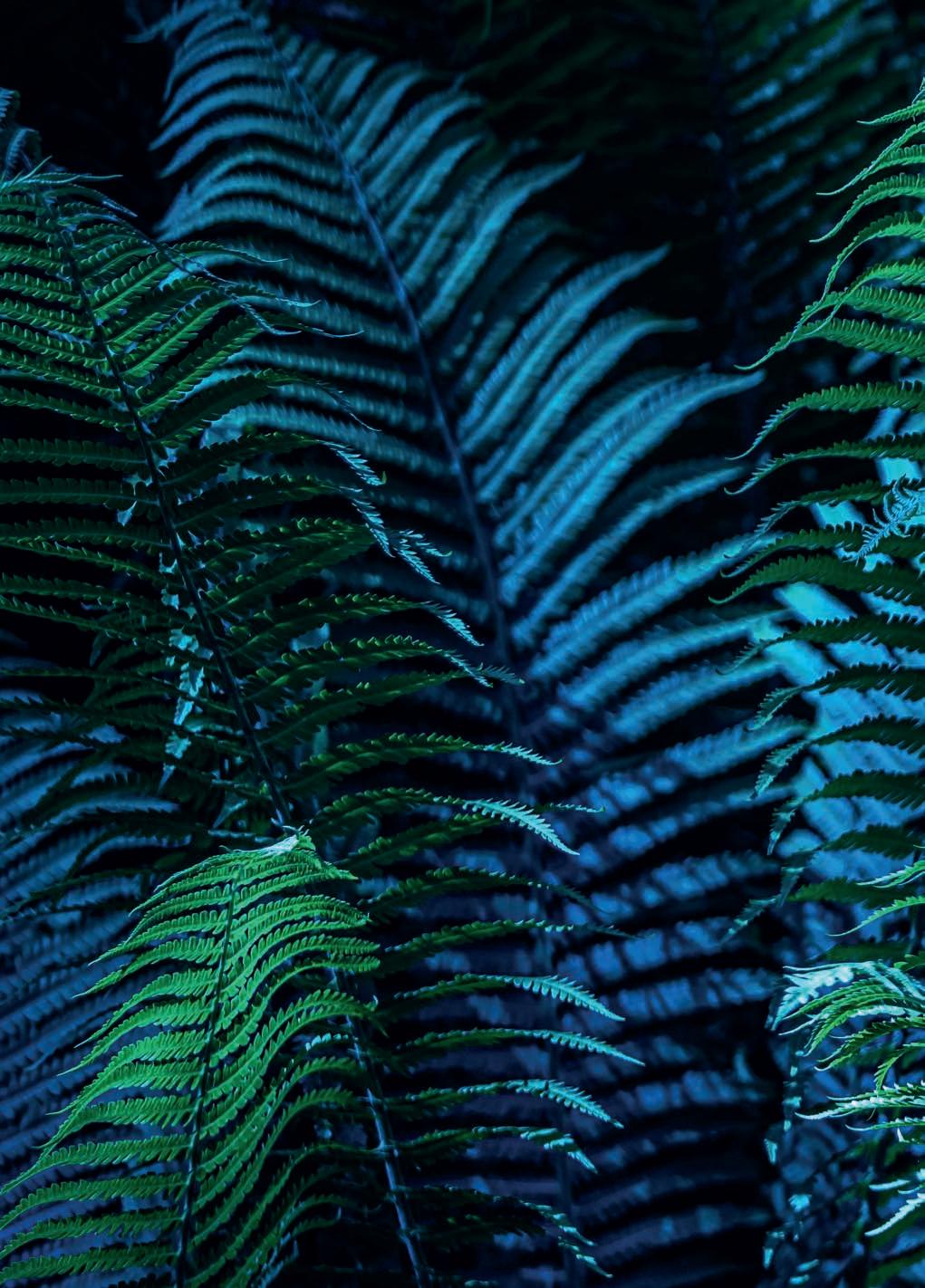
SIGN UP!
Dear Diary… Your day as a conservationist
Fancy yourself as an explorer? Want to travel the world is search of new and exciting species? Our reptile and amphibian team have helped describe five Vietnamese species of frog and a snake, new to science, since 2017 alone. But, before you think that it’s all globetrotting and discoveries, it involves a lot of hard work too. When you enter The Secret Life of Reptiles and Amphibians you’ll
The Secret Life of Reptiles and Amphibians opens later this winter. Sign up to member emails at zsl.org/membership to make sure you don’t miss our member-only opening. 1kg
get a taste of life in the field – sit in a Philippine canoe, imagine life under a tarpaulin tent, learn to distinguish frog calls and swab frogs for samples. You’ll even be able to read our conservationist’s field diary. If climbing mountains, camping in the jungle and clambering through icy streams in search of new species is your cup of tea, we could make an explorer of you yet!
Meet the mammoth frog
If there was an award for the animal kingdom’s strangest name, the mountain chicken frog would surely be a contender. It’s neither a mountain nor a chicken. But it is massive and, according to locals, tastes like chicken. In fact, mountain chickens are one of the world’s largest frogs and can weigh up to 1kg (that’s five adult squirrel monkeys to you and me). Unfortunately, mountain chickens are also incredibly rare on the Caribbean islands of Montserrat and Dominica, where they’re from, with many of them wiped out by the spread of a fatal amphibian disease known as chytrid. London Zoo is part of a partnership of five zoos breeding the frogs, in the hope of one day restoring them to the wild. We’re also working on ways to counter chytridiomycosis, the disease that led to their decline in the wild.
6 WILD ABOUT / AUTUMN 2023
Enter
A real head-turner
Seventy million years ago, around the time that the triceratops is thought to have evolved, a plucky group of turtles decided to go their own way in the world. Snake-necked turtles diverged from all other species in their evolutionary path, developing long necks for hunting amphibians, insects and fish. There are 17 species of snake-necked turtles in the Chelodina genus, and the rarest of them all is the Roti Island snake-necked turtle – which is so rare that scientists think they could even be extinct in the wild. They’re named for a small Indonesian island called Rote, where they were first found, but they’ve been hunted and collected to sell as pets.
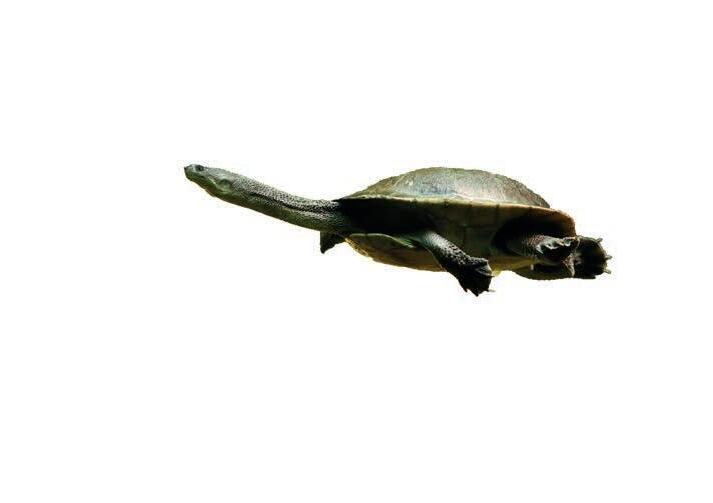
Go underwater with the Chinese giant salamander


Meet the daddy of all salamanders. London Zoo is the only Zoo in the country to provide a home for these giants, whose ancestors evolved 170 million years ago – twice as long ago as the T. Rex. can grow to almost two metres long and weigh over 30kg – that’s the height of an adult man, and two or three times the weight of the average pet dog. Despite these awesome statistics, the Chinese giant salamander is a shy creature, favouring shadowy underwater caves and river bottoms. This might be down to them having been hunted close to extinction and prized as a valuable delicacy in China. It also explains how our Chinese giant salamanders arrived at London Zoo: they were rescued while being smuggled into the UK and were delivered to us to care for.
animal you’ve never

Meet one of the weirdest (but most interesting) animals at London Zoo: the aquatic caecilian. Where do we begin? They look like large worms, or really wet snakes, but they are in fact legless amphibians. They don’t lay eggs, like many other reptiles and amphibians: they give birth to live young, pregnancy can be up to eight months, and the babies can grow to almost half the length of their mothers at birth! Like most amphibians, caecilians can breathe through their skin, meaning that they rarely need to surface for air. Aquatic caecilians live under water, but the majority of caecilians live underground in wet and muddy jungles.

7 WILD ABOUT / AUTUMN 2023
CAN I TAKE YOUR ORDER?
In London Zoo’s restaurant we serve up hot chocolate, cakes, stone-baked pizzas and sustainably caught fish and chips. But what if we told you that’s barely a slice of what’s available to eat at the Zoo? If you’re not human, that is. Our nutritionists cater to the tastes of the whole animal kingdom (and that includes some very strange tastes indeed).
OPEN DAILY 6AM-11PM FREE DELIVERY
SAFARI KING MENU
Snacks
Waxworms for aye-ayes
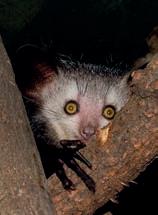
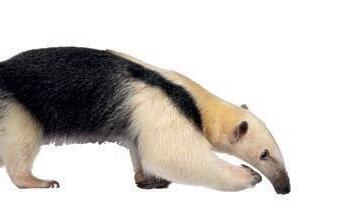
We poke these juicy grubs into hollow sticks, so our aye-ayes can use their long, spindly middle finger to scoop them out.
Long-legged lunch
Protein-rich and packed with nutrients, crickets are a staple diet for many animals at the Zoo – from meerkats to chameleons. We breed our own crickets, to save us transporting them from elsewhere, and every day around 20,000 crickets are born. That’s seven million a year!
Drinks
Fruit tea for gorillas
We make fruit tea by the bucket load during summer, freezing it into ice lollies to keep our great apes cool.
Ant smoothie for tamanduas
Nicknamed ‘ant bears’ for a exclusive diet of mashed
Fish milkshake for penguins

There’s only one thing a penguin chick wants for tea: fish milkshake! Normally the parent makes it for their chick, partially digesting and regurgitating the fish, but when we handrear chicks we have to make it ourselves –using a food blender.
Daily Special
Strong stomach stew
Sloth babies eat their mum’s poo to acquire their gut bacteria, which helps them break down plants. It might sound gross but it’s more common that you think – other animals, like elephants, do it too!
Salads
Leaves for herbivores
Giraffes, okapis, colobus monkeys and other herbivores demolish a forest-worth of leaves and branches every year. We grow a lot of it at Whipsnade!
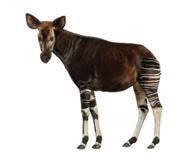
Coriander for giant jumping rats

We grow a variety of herbs in the greenhouse. For some it’s an important part of their diet; for others the smell is fun and stimulating– like catnip for our big cats!
£5
Feed a gorilla for a fiver
Text SNACK to 70450 to donate £5 to the care of our gorillas and other animals.

Texts will cost the donation amount plus one standard network rate message, and you’ll be opting into hearing more from us. If you would like to donate but don’t wish to hear more from us, please text SNACKNOINFO instead.
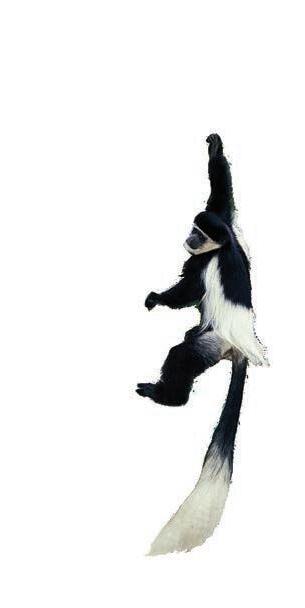
WILD ABOUT / AUTUMN 2023 8
“I must have been eight or nine the first time I came to London Zoo,” says Yasmin. “It was on a primary school trip, and I remember my mum signed up as a support parent for the trip. She loves animals, so she’ll use any excuse!”
Yasmin puts a lot of her love for animals down to her parents and trips to the Zoo together as a family, and has a soft spot for the world’s tallest land animal: “Giraffe are my favourite animal at London Zoo,” she says. “I’m quite tall, so I think I relate to them. I also like that they’re an underdog – a lot of people view them as clumsy and silly, when they’re actually graceful and clever.”

More than 15 years and many more trips to the Zoo later, Yasmin is now an Environmental Consultant in the transport industry, advising companies on how to minimise their environmental impact. She’s also been recently appointed as chair of ZSL’s new Youth Advisory Board, a group of 16- to 25-year-olds tasked with helping to shape the future of ZSL, ensuring that the organisation matches the needs of young people.
“Our mission is to think about how we can get more young people interested and involved,” says Yasmin. “At the moment, getting involved in wildlife conservation often relies on a parent or a teacher being interested in conservation. I was lucky enough to have that, but it can be a hurdle for young people with parents who aren’t interested in wildlife – so how do we expose more young people to conservation?”
Social media could play a valuable role, says Yasmin. “Social media has been so important for the way our generation share knowledge and raise awareness. It’s going to be integral to conservation efforts too –just think about how many people now know about rare animals that are going extinct, through social
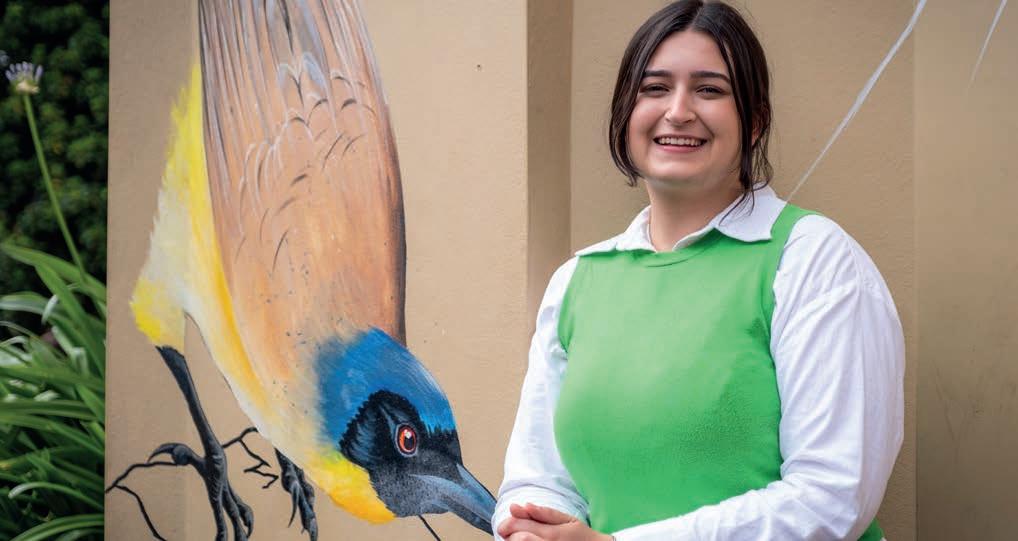
For Yasmin, she’s also keen to see more representation of people of Arabic background at the Zoo. “My dad is Iraqi
and English isn’t his first language so, on our visits together, I would often translate the signage around the Zoo from English into Arabic for him. I’d love to create a partnership with a local Arabic school or another language school to increase awareness of conservation in other languages.”
It doesn’t stop there. The board want to be part of a national movement of young people, striving for the protection and restoration of wildlife. “There are a lot of different youth boards across the UK, and we want to establish a national network between organisations and schools across the country. We all have to work together to be the change we want to see.”
We want to hear more of your stories! Get in touch at wildabout@zsl.org to share your experience of being a member.
ZSL ADVISORYYOUTH BOARD
To learn more about ZSL’s Youth Advisory Board, visit zsl.org/zsl-youth-advisoryboard

9 WILD ABOUT / AUTUMN 2023
Yasmin Sajjad on her role chairing ZSL’s newly formed Youth Advisory Board
“...it can be a hurdle for young people with parents who aren’t interested in wildlife.”
WHIPSNADE ZOO
21–29 OCTOBER*
LET’S GET SPOOKY
LONDON ZOO
21–31 OCTOBER
1 2
This October half term, Boo at the Zoo is back! With this year’s theme of unseen animals, get to know which animals prefer nighttime through terrifying animal talks. Your little devils will also enjoy a spooky magic show, a Halloween disco, spine-chilling storytelling and a ghost trail on our steam train. For those feeling a bit crafty we even have face painting and pumpkin decorating.**
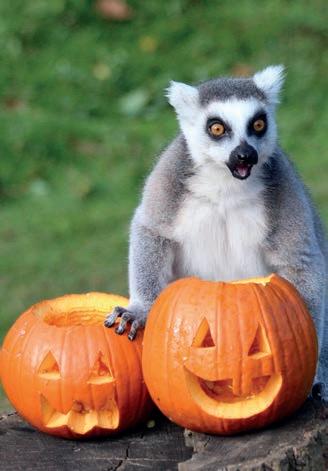
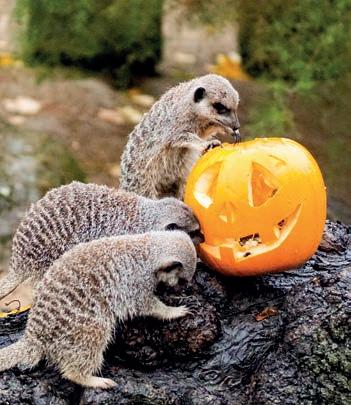
October. **Extra charges apply for steam train, face painting and pumpkin decorating.
Calling all little monsters and fearless families, join us for a frightfully good Halloween this half term with Boo at the Zoo. Navigate through the extinct species graveyard, head to Ghoul School to learn spells, or get hands-on with pumpkin decorating and mask making. We’ll also have terrifying talks and devilish demonstrations, perfect for animal lovers, and youngsters will be able to transform into black cats, spiders and other Halloween creatures with the help of the Zoo’s Fearsome Face Painters.*
*Extra charges apply for face painting and pumpkin decorating.
10 WILD ABOUT / AUTUMN 2023
3
THE MAGIC OF CHRISTMAS
LONDON ZOO
25 NOVEMBER – 7 JANUARY
Get in the Christmas spirit with festive events across the Zoo. Magic isn’t just reserved for reindeer, so this year we’re giving our animals a chance to show Santa what they’re made of! It’s up to you to decide who is best for the job with the Christmas sleigh trail. Over in Santa’s grotto, youngsters can learn what it takes to become an elf in elf school, before meeting Santa* to receive a special gift. Don’t miss our animal advent calendar, where we’ll be celebrating one animal every day in the run up to Christmas.
*Meet Santa sessions are not included in Zoo entry and must be pre-booked.
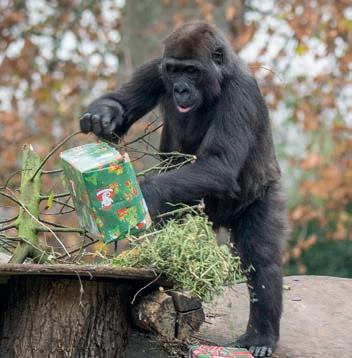
FIND OUT WHAT’S ON AT OUR ZOOS
THINGS TO DO THIS SEASON VISIT
NIGHTMARISH NATURE
*Selected activities run until
31
Tuck your toes into some thick winter socks and order yourself a hot chocolate with marshmallows – winter is around the corner and it’s time to get festive at the Zoos. Pop our dates in the diary so you don’t miss out and keep an eye on member emails for updates and timings
FESTIVE FUN AT WHIPSNADE

WHIPSNADE ZOO
25 NOVEMBER – 24 DECEMBER*
This year, stop by Whipsnade Zoo’s cosy Lookout Lodge to meet Santa** and receive an early Christmas gift to take home. For an additional treat before meeting the big man, why not join our elves to make animal gifts, and then head on a tour to deliver your gift and watch our animals get stuck in? For those who want the full Christmas experience, you can even join Santa and his elves for Breakfast Storytime. This is sure to knock the socks off any youngster.
*Weekends from 25 November then daily from 16 December.
**Meet Santa sessions are not included in Zoo entry and must be pre-booked.
SAVE THE DATES
Tear me out and stick me next to your calendar or on the fridge
BUDDY UP WITH A BIG CAT
LONDON AND WHIPSNADE ZOOS VARIOUS DATES
VETS IN ACTION
LONDON ZOO: 10–18 FEB
WHIPSNADE ZOO: 17–25 FEB
Get nose-to-nose with our Amur and Sumatran tigers in new experiences at both Zoos. At Whipsnade you’ll be able to feed our giant Amur tiger Czar, while at London you’ll meet our Sumatran tiger family. At London you’ll also be able to go behind the scenes with a keeper to prepare our enrichment for our tigers and learn about how we train them for medical checks. Gold Members, Fellows and Patrons even get 10% off any experience; visit our Zoo websites to learn more. 4 5 6
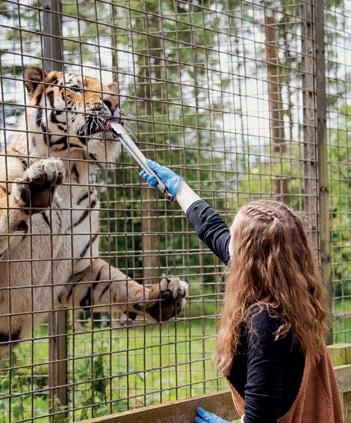
Vets in Action is back this February half term! Budding young vets can experience firsthand what it takes to be a vet at the Zoo in our fun, role-playing vet experience. After reporting for duty at the specially created animal hospital reception, junior vets will pop on their white coats and join the team in the Zoo’s clinic to experience the huge variety of work carried out by the Zoo’s vets, vet nurses and zookeepers.

AND WHIPSNADEZOO.ORG/WHATS-ON
LONDONZOO.ORG/WHATS-ON
11 WILD ABOUT / AUTUMN 2023
BEAR NECESSITIES
Come down to the woods today and find out what our bears get up to. Zookeeper Angela Robinson walks Wild About through our brown bears’ daily routine

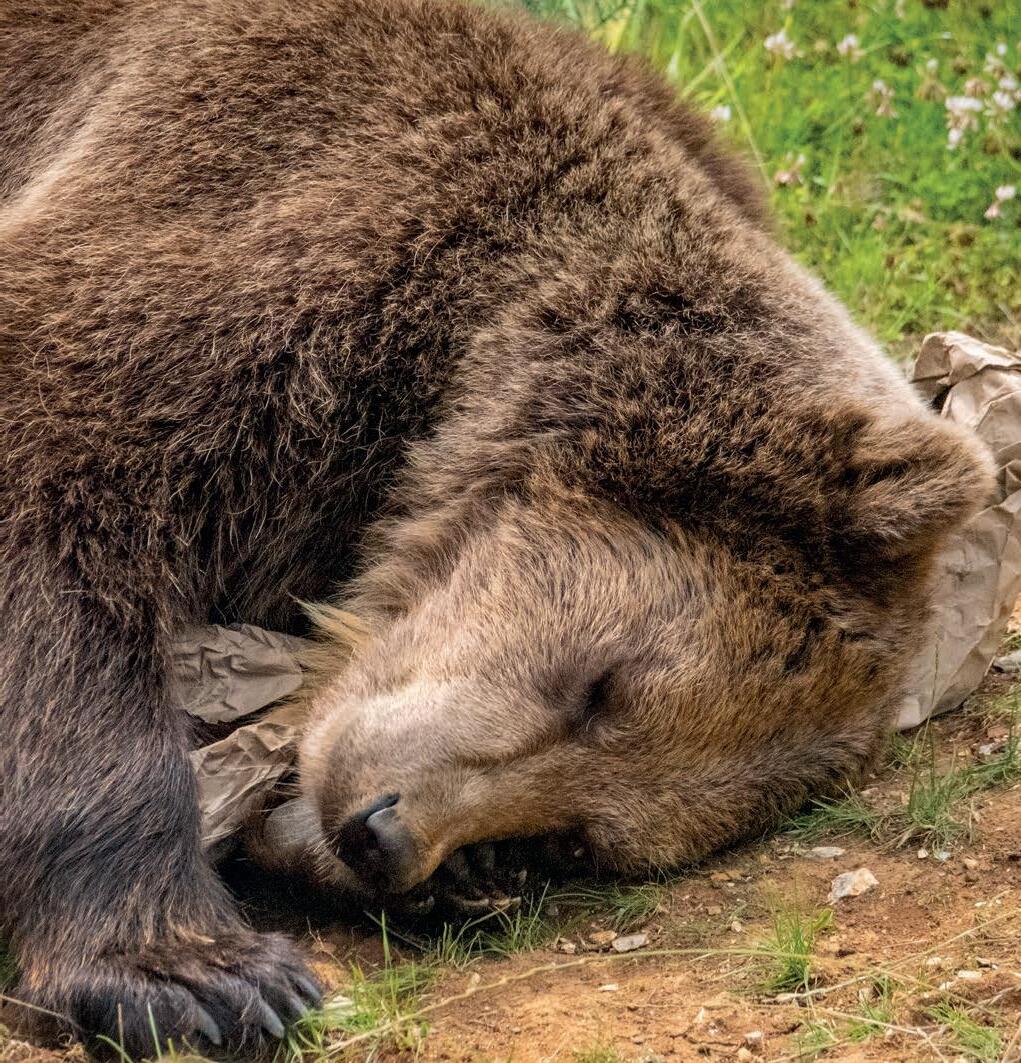
08:30
WAKEY WAKEY
RISE AND SHINE!
Our first job of the day is to get the brown bears out of bed – and it can take a bit of encouragement! The girls are very sleepy in the morning and spend a lot of time yawning and squirming in their hay beds. We give them some food first thing, which normally gets them up and at ‘em, but sometimes they’re so bleary-eyed it can take a while.
BUSY BEES
Bears really will do anything for honey, so we use honey water as a treat when we’re training them. We train our bears to take part in health checks, or to have any injections or medication they may need.
WILD ABOUT / AUTUMN 2023 12
MINNIE ROLLING IN ANISEED OIL SPRINKLED ON CARDBOARD
10:00
SCENT OF ADVENTURE
Once everyone’s had a bit of breakfast it’s time to head into their forest to explore. Bears are natural foragers so, before they venture outside, we hide lots of food and create scent trails for them to discover. This might be up trees, buried underground or in puzzle feeders dotted around. Cinderella is the oldest and largest of our four females, so she’ll spend a bit of time letting the other girls (Mana, Minnie and Naya) knowing who’s boss. Once everyone’s settled down they’ll spend time foraging for the food we’ve left or napping. Bears love to nap.
POWERFUL SNOUTS
Bears have one of the strongest noses in the animal kingdom. Our bears love the scent of aniseed oil so we often sprinkle some on a hessian sack. They behave just like cats with catnip!

LADIES WHO LUNCH
Three times a week our bears get a joint of venison or horse meat each, which tends to send them into a food coma for the afternoon. On Wednesdays they have fish, which we often hide around the trees or, if it’s hot, freeze in ice blocks for the bears to break apart and slurp up. Bear diets are really varied, so we also give them lots of root and leafy vegetables too, and nuts in the autumn when they’re starting to put on weight for winter. Supermarket fruit is a bit too sugary for our bears, but they do forage for berries from the trees in their forest home. One of Naya’s favourite foods is beetroot. She’ll hoover up all the beetroots and leave purple poos around the forest for us to find.
TOP OF THE CLASS
15:30
GO TO BED SLEEPYHEAD
Bears are extremely intelligent predators. It makes them a joy to work with as they’re so enthusiastic and inquisitive about anything new we offer them.
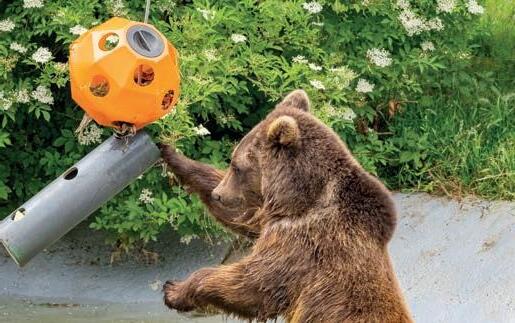
Naya, our youngest bear, is a bit naughty. She would rather stay outside playing than go to bed – so we start calling the bears in for bed well before we finish our jobs for the day. First we fill their bedrooms with lots of enrichment – more puzzle feeders or treats to explore. Once they’ve finished eating, all the playing, running around and splashing in the pool seems to catch up with them and they get very sleepy. They usually curl up for bed by 8pm.
LAST CHANCE TO SEE
When winter sets in, our bears will go into torpor. It’s not quite full hibernation –it’s not cold enough for that here – but they’ll sleep a lot in their dens and won’t eat much. Be sure to visit them before they settle down for winter!
 CINDERELLA ENJOYING HER LUNCH
NAYA WOULD RATHER PLAY THAN GO TO BED
CINDERELLA ENJOYING HER LUNCH
NAYA WOULD RATHER PLAY THAN GO TO BED
13 WILD ABOUT / AUTUMN 2023
MANA WORKING HARD TO EXTRACT THE FOOD FROM A PUZZLE FEEDER
12:30
AN EPIC VOYAGER
Conservationist Elizabeth Witcombe lifts the lid on the curious life of European eels


1. Seasoned travellers
When European eels arrive in our rivers they’re just 8cm long and transparent, but they’ve already travelled 6,500km. That’s because all eels hatch from eggs in the Sargasso Sea, an area of the North Atlantic Ocean. They spend the first year or two of their underwater life as larvae, floating towards Europe on the ocean currents, before transitioning into glass eels as they reach European waters.
FACT FILE
Eels are an important food source for the UK’s other wildlife, like otters, bittern, osprey and herons. They also scavenge on decaying matter, keeping our rivers healthy.
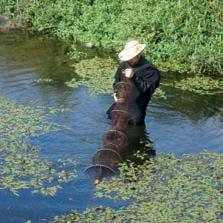

Eels migrate 13,000km during their lifetime. That’s like swimming from London to Edinburgh 20 times!
4. The return voyage

All of their hard work over the last few years has been leading up to this moment: the eel makes its final transition into an adult silver eel. Their silver colour will help camouflage them from the countless predators they will face on the return journey to the Sargasso Sea. The adult eel will now need all the weight and strength it’s built over the last decade or two to swim 6,500km to their birthplace. For eels that do survive the migration, they achieve their ultimate goal: the chance to breed with other eels and lay their own eggs.
6,500km
Sargasso Sea (spawning area)
14 WILD ABOUT / AUTUMN 2023
SCIENTISTS CATCHING EELS ON THE AZORES TO TRACK THEIR MIGRATION
UNDER THE MICROSCOPE UNDER THE MICROSCOPE
3. A safe haven
Once they’ve found a safe spot to feed and grow, the elver begins the next part of their lifecycle, becoming a yellow eel (named because of their yellow tummies). They can spend 20 years in our rivers, feeding and growing up to one metre in length and weighing up to 6kg – that’s about the same as a domestic cat. It’s also at this stage when they’re most likely to be affected by pollution in our rivers, like sewage leaks.
2. River navigators

Having survived their mammoth voyage and arrived in the Thames Estuary, glass eels begin transitioning into elvers – up to 12cm long and a dark brown colour. They journey up the Thames and into our system of tributary rivers, looking for a home where they can feed on insect larvae, crustaceans and other fish. The Thames River system is highly fragmented, and the elvers face over 2,000 barriers to their migration, like weirs and dams. We install specially built eel passes to help them access areas of rivers that have been cut off to them.
Cracking the case
Until 2022, no one was sure where eels came from. It had never been proved that eels bred in the Sargasso Sea. Last year, ZSL’s scientists cracked the case. By catching adult eels in the Azores and fitting them with satellite tags, our scientists were able to watch the eels return to their mysterious breeding grounds in the Sargasso Sea.
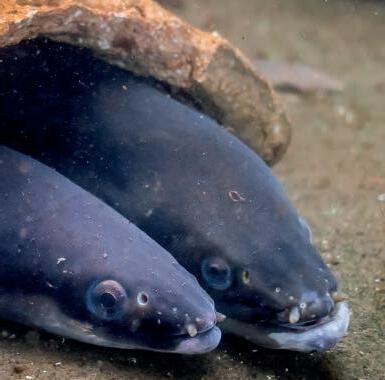
Perfect pass
Eel passes are also known as ladders, because they contain grooves or bristles that help the eel climb up them and into the river beyond. Our scientists are working on the ultimate eel pass. It involves presenting different ladders to eels in our labs at London Zoo, filming their ascents, and using AI to process the results. No eels are harmed – we return the eels to the river after they have attempted one ascent.
FACT FILE
We have made 189 hectares of additional habitat accessible to eels in the Thames River Basin by installing eel passes over weirs that had blocked their migration.
Get involved
Become a ZSL citizen scientist and help us monitor eel migration in the Thames and its tributary rivers. Our eel volunteers regularly check eel traps placed around Greater London, counting and measuring the eels before releasing them. The data helps us understand how many eels are surviving in our rivers. Or why not download the app River Obstacles, that lets you mark down on a map if you see any barriers to eel migration when you are out and about. zsl.org/thames-volunteer
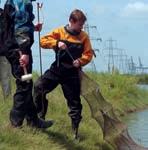
 Thames Estuary
Thames Estuary
15 WILD ABOUT / AUTUMN 2023
ZSL STAFF INSTALLING AN EEL PASS ON THE RIVER DARENT
COOL CRITTERS
From mountain top to jungle stream, from tree canopy to underground – The Secret Life of Reptiles and Amphibians is home to the weirdest, most wonderful, colourful and loveable reptiles and amphibians from around the world
NOTFOR GROWN UPS!
LIGHTS OUT!
Someone’s turned the lights out in the new reptile and amphibian house, but we need to check our animals are tucked in for the night. Can you match their description to their silhouette? Write your answers in the white box above the names of the animals below.
SPOT THE DIFFERENCE
JOKE What type of shoe do wear?frogs
Open-toad sandals!
Roti island snake-necked turtle
The Lake Pátzcuaro salamander lives in a single lake in Mexico. The salamanders have the ability to regrow their limbs, which has made them especially of interest to scientists. Can you spot the FIVE differences between these two amazing salamanders?
DID BritainKNOW?YOU
As their name suggests, this turtle has a long, snake-like neck. It does mean that they can’t retract their head into their shell.
King cobra
The largest of all venomous snakes, the king cobra has a trademark ‘hood’ around it’s face which it uses to frighten off other animals.
DID YOU KNOW?
Amphibians evolved from fish around 400 million years ago. Giant amphibians were once very common, before the dinosaurs came along!
has six native species of reptile, including slow worms and grass snakes.
Philippine crocodile
These small crocs are down to just 100 in the wild. They are constantly growing new teeth, and can go through 4,000 in a lifetime.
JOKE What reptile lives in the snow? A blizzard







Poison dart frog
These tiny frogs use brightly coloured skin to advertise how poisonous they are, to avoid being eaten.
WILD ABOUT / AUTUMN 2023 16
1 3
2
1
2 -
3 -
4 -
ANSWERS:
Philippine crocodile.
Roti island snake-necked turtle.
Poison dart frog.
King cobra 4
ONE IN A CHAMILLION





The panther chameleon is one of the largest and most colourful of all chameleon species. And unlike many chameleons, they use their bright colours to communicate their mood rather than to blend into their environment. If the chameleon is feeling excited or territorial they will show red, yellow and orange, but they’ll turn blue and green if they’re relaxed. Chameleons also have super tongues, which they can shoot out of their body at four times the speed of a bullet (9,000kmph). The end of their tongue is covered with sticky mucus, which attaches to an unlucky insect before reeling it into the chameleon’s hungry mouth.
Send us a picture of your colourful creation to be in with the chance of winning a cuddly chameleon from the ZSL shop! Ask a grown up to take a picture of your entry and email it to us at wildabout@zsl.org with your name, age and postal address by 1 January 2024. Email the same address for full terms and conditions.

17 WILD ABOUT / AUTUMN 2023
Wild About meets amphibian scientist Gonçalo M Rosa to learn about life studying frogs in the rainforest
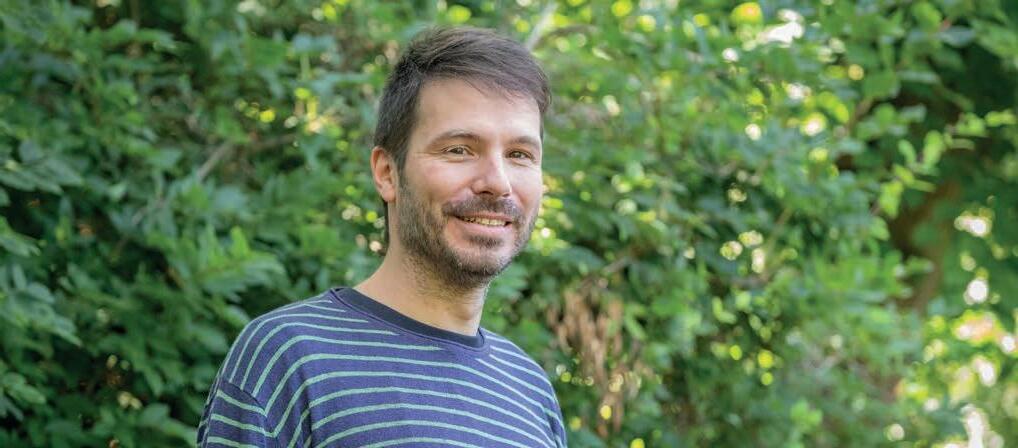
WILD LIFE
I DO MOST OF MY WORK AT NIGHT…
Because so many frogs are nocturnal. It might sound strange, but I love working at night. Even though you can only see a few metres in your torch light, there’s so much going on. The rainforest comes alive at night, and the sounds of frogs, crickets and other insects can be deafening. Of course, you do sometimes get the feeling that something is watching you from the darkness.
I’VE ONLY MET A JAGUAR ONCE…
My research assistant and I were looking for a particular type of frog, and we heard a large something fall from a tree behind us. We spun around and saw two eyes looking at
I’VE WANTED TO BE A SCIENTIST…
Since I was a child. I’m from Portugal, born and raised in Lisbon, and from an early age I went regularly to my local zoo and attended their summer programmes in the school holidays. When I was old enough I started volunteering there, and I eventually got a job – first in the reptile and amphibian section, and later with the education team. Doing a biology degree was a natural next step if I wanted to keep working with wildlife.
I DON’T REALLY HAVE A FAVOURITE ANIMAL…
I’m just a very curious person that loves all wildlife. I get easily amazed and want to know what they’re doing and watch them go about their lives. Amphibians and reptiles are often the easiest to spot in the wild, so that created an easy connection for me. And the fact that some people don’t like them that much just fascinated me even more.
THE BEST THING ABOUT FROGS IS…
Their diversity. We have over 8,500 known species of amphibians, all of them with different colours, shapes, sizes, traits and behaviours. There are frogs that lay thousands of eggs but never meet their offspring. Some frogs carry their tadpoles on their back, looking for the best tiny pool where their
young can develop. There are even species where the tadpoles develop underneath their parent’s skin and erupt out of it when they are old enough. The diversity is unbelievable and, for me, it´s mesmerising.
I’M CURRENTLY STUDYING THE LEMUR FROG…
These beautiful frogs are found in Costa Rica and Panama. During the late 1980s, they began to disappear, likely due to the spread of chytridiomycosis, an amphibian disease caused by a chytrid fungus. This pathogen has already been linked to the extinction of 90 amphibian species across the world, so it’s urgent we find a cure.

LEMUR FROGS ARE SPECIAL BECAUSE…
Some populations have shown signs of recovery in areas where they had disappeared. These frogs may hold the key to immunity from or coexistence with the disease. By learning how they’re doing it, we might be able to help other amphibian species recover too.
MY ADVICE TO YOUNG SCIENTISTS IS…
Follow your passion and embrace curiosity. Nurse it, value it. Stay resilient in the face of challenges, learn from failures, and build a supportive network. Anything you find interesting, go for it!
The rainforest comes alive at night, and the sounds of frogs and insects can be deafening.
WILD ABOUT / AUTUMN 2023 18
WADDLE I DO WITHOUT YOU?
Is there a penguin-shaped hole in your heart? Little ones (and big ones) will be able to recreate life on icebergs and under the waves with our range of soft toys, which includes three species of penguin: emperor, rockhopper and Humboldt. They range from mini bean toys, ideal travel companions on long journeys, to our giant XL emperor penguin and chick, which also makes a great prop for parties and photoshoots.
HAPPY SOCKS, HAPPY FEET
Keep your flippers toasty this winter with our animal-themed range of ZSL-branded Happy Socks. The socks are made with organic cotton, come in adult and children’s sizes and are exclusive to ZSL. As well as penguins, you’ll find elephants, giraffes, turtles and many more to collect.
DON’T FORGET
Gold Members can grab 10% discount in our shops and on experiences using code OSTRICH10
P-P-P-PICK UP A PRESENT
This Christmas, we’ve got the perfect presents for the penguin-obsessed loved one in your life. Or if that penguin obsessive is in fact you, what better way to see in 2024 than a bit of self-gifting? Every purchase from our shops supports our penguins at the Zoo and our work protecting animals around the world.
shop.zsl.org
LICENSED TO CHILL
On days when the weather is against you, or when you want to relax after a busy morning, win the day with one of our puzzles and boardgames. Wind down with a penguin-shaped puzzle, keep youngsters quiet with one of our craft sets or get the whole family together to play a boardgame.
TREATS FOR LITTLE FLIPPERS
Did your little one fall in love at Penguin Beach? We have a range of gifts designed to keep your young chicks excited about penguins, from wooden toys and puzzles to penguin-themed crockery that are both eco-friendly and durable.

19 WILD ABOUT / AUTUMN 2023
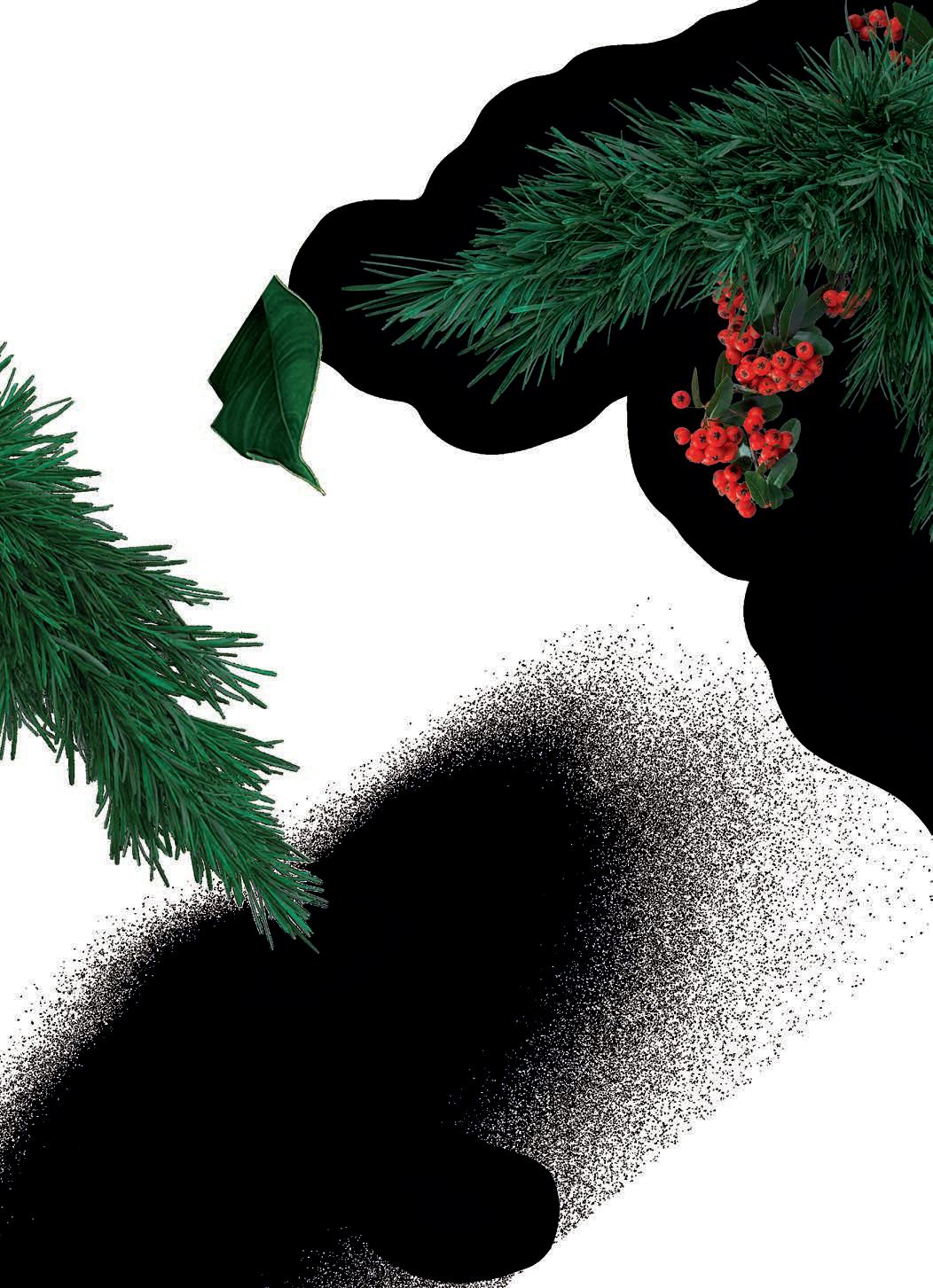
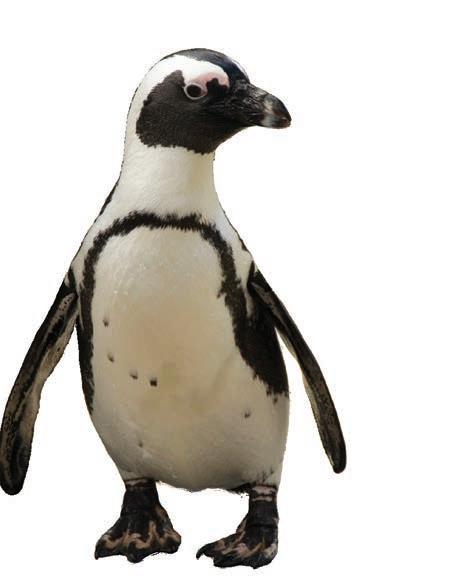
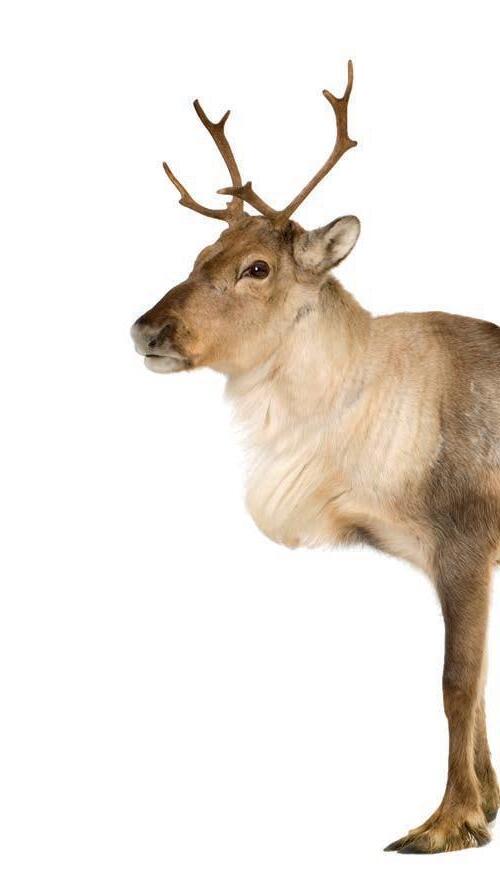

25% OFF when you buy 2 * GIFT MEMBERSHIP GIFT A YEAR OF WONDER-FULL DAYS OUT ZSL is a charity registered in England and Wales no: 208728 working globally. londonzoo.org/gift-membership Treat your loved ones to memories that last a lifetime. *Limited time only, buy 2 Gift Memberships for 25% off with code EARLYBIRD23. Offer valid until 31 October 2023. Buy a Gift membership today.

















































 CINDERELLA ENJOYING HER LUNCH
NAYA WOULD RATHER PLAY THAN GO TO BED
CINDERELLA ENJOYING HER LUNCH
NAYA WOULD RATHER PLAY THAN GO TO BED








 Thames Estuary
Thames Estuary







